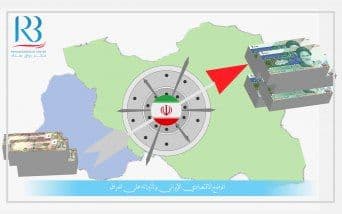 2021 / 27 / Mar
2021 / 27 / Mar
The Iranian economic situation and its effects on Iraq
Mustafa Al-Saadi
Inflation in Iran
Inflation in the Iranian economy turned into an almost normal matter, which all governments suffered from, but the difference is in the rate of that inflation that differs from one government to another. Therefore, there is no period of time free from inflation in the Iranian economy. One of the most inflationary periods that the Iranian economy passed in sequence was during the Iran-Iraq war and the last two years of Ahmadinejad’s government and the second period of Sheikh Hassan Rouhani’s government, where the exchange rate of hard currencies rose to nearly seven times, and as a result all prices rose, the most important of which is real estate, as it rose to nearly six times as well, and thus had a significant impact on the economic situation of the The Iranian citizen, especially after the imposition of sanctions by the US government on all aspects of the Iranian economy. Accordingly, the Iranian economy has suffered many problems, the most important of which is the failure to export Iranian oil, and since the Iranian economy depends largely in its financial revenues on the export of crude oil, thus this economy has lost the main source of financing its general budget. To address the matter, those in charge of managing the economy should have found alternative solutions to provide what Iran needs of hard currency to import what they need of basic or non-essential goods. Therefore, they worked to increase the export of non-oil products to the rest of the world and to export some oil derivatives such as gasoline and gas to some countries such as Venezuela and Iraq.
The main destinations for Iranian goods
In 2020, China and the countries surrounding Iran represented the largest importers of Iranian non-oil goods: -
1- China 25%.
2- Iraq 22%.
3- Türkiye 14%.
4- UAE 9.4%.
5- Afghanistan, 5%.
The most important goods that were exported to China were furniture and handicraft products, as well as a number of basic materials needed for some industries. Also, one of the most prominent Iranian products exported to China was Iranian saffron, which is known for its quality. As for Iranian exports to Turkey, it was petrochemicals, liquid natural gas, minerals, some vegetables and furnishings.
It is worth noting that many goods are exported as raw materials used in production or exported without packaging, such as saffron, which is exported to the UAE in large proportions and to a number of other countries as well, such as Spain and Canada, where it is packaged in those countries and sold at very high prices, and this prompted many economic experts in Iran to demand stopping the export of such goods because this leads to Iran obtaining very large revenues if they are packed in Iran and then exported to different countries, and in addition to that, many job opportunities are provided for the unemployed. About the work whose numbers began to increase day by day in Iran.
In addition to the American sanctions, there is an economic war waged against Iran, by working as much as possible to extract hard currencies and gold from Iran through wide networks, some of whose members are caught from time to time, and therefore the Iranians found that they had to confront that economic war, and that confrontation was in several ways, including working to dismantle these networks and facilitate tourism for foreigners, as well as facilitating university studies for foreign students, all of which led to Iran obtaining a lot of hard currency that it needs and compensating a large part of the losses it suffered in this economic war.
In 2019, the number of foreign tourists visiting Iran increased by 30%. Most of the tourists visiting Iran are from Iraq, then from Azerbaijan, Afghanistan, Turkey, Pakistan and Armenia. As for foreign students studying in Iranian universities, their number was nearly forty thousand in 2019, and this number has increased greatly at the beginning of 2021, as the percentage of foreign students at Azad University alone increased by nearly 450%, according to the statistics of the university itself.
Economic relations between Iran and Iraq
Iraq is considered one of the most important export destinations for Iranian goods. The export of Iranian goods to Iraq increased after 2003, reaching nearly $2.7 billion in 2008. Exports to Iraq accounted for 15% of all Iranian exports. In 2019, the export of Iranian goods reached nearly $9 billion. In 2020, the import of Iranian goods increased by not a small percentage. For Iraq, then the volume of economic exchange between the two countries will reach nearly thirteen billion, which constitutes 22% of all Iranian exports last year, and this year Iranian exports to Iraq amounted to 27% of all Iranian exports, and thus Iraq became the most importer of Iranian goods and China occupied the second place after Iraq.
As mentioned previously, Iraq has imports in the field of energy from Iran, and this is divided into two parts, gas and electricity. The Iraqi Ministry of Electricity concluded two contracts, each for a period of six years, with the National Iranian Gas Company in 2013 and 2015 to provide what gas stations need to generate electric power. The source at the beginning of 2018 amounted to approximately 14 million cubic meters of gas required to generate 2,800 megawatts of electric power. In the field of electric energy, Iran exports approximately 1,200 megawatts to Iraq, and accordingly, Iran provides a total of 4,000 to 4,200 megawatts through the exported gas to operate gas stations, as well as exporting electric power directly.
As for Iranian exports to Iraq in fields other than energy, they are distributed among several commodities, most notably construction materials, foodstuffs, vegetables and other products, which amounted to 17 million and 600 thousand tons during the first seven months of the year from March 21 to October 22 of the year 2020.
As for tourism, and on the basis of what the specialists in this field have announced, Iraqi tourists go to Iran either to visit the holy shrines in Qom and Mashhad, or for treatment in Iran, and that those who go to Iran for treatment costs thousands of dollars and much more than those who go to visit the holy shrines. Thus, on average, every Iraqi who goes to Iran costs a thousand dollars, and given the number of tourists that reached more than one million and 700 thousand tourists in the first six months of March 21-September 23 of the year 2019, and this number is more than t The number of Iraqi tourists to Iran in the same months of the year 2018 was about 426,000 tourists, which indicates the facilities that Iran has created to attract the largest possible number of tourists to visit their country, and in addition to that, the free zones near the border cities that Iran created by allowing Iraqis to enter without a visa in the cities of Khorramshahr and Abadan led to the fact that many Basrans began to go to these two cities to shop for their daily needs, which led to an increase in prices in those cities, which had an impact The negative impact on the Iranian citizen who resides in those two cities, as well as on some shopkeepers in the popular markets in the city of Basra.
As for students, most of the foreign students studying in Iran are Iraqis, and it has been announced that 70% of foreign students in medical specialties are Iraqis, and there is a noticeable increase in the number of Iraqi students studying in Iran year after year, and this has a major role in bringing hard currency to Iran.
It is worth noting that the economic exchange between Iraq and Iran is largely unilateral, as Iraqi exports to Iran during each of the past ten years are equivalent to no more than 100 million dollars, an amount that cannot be compared to what Iraq imports of Iranian goods, and the Iranians plan for Iranian exports to Iraq to reach twenty billion dollars in mid-2021.
Some Iranian experts in economic affairs believe that Iran, in order to maintain its position in the Iraqi market and increase its contribution to this market, must adhere to several issues, including:
1- Increasing the types of exported goods
Not being limited to the goods that are exported now, but rather increasing the types of exported goods, especially after Iraq took policies to protect the national product of vegetables and other foodstuffs, and therefore the types of exports to Iraq must be increased to include technical, engineering and technological services.
2- Executing part of the reconstruction projects
One of the most important things that must be done in the Iraqi market and to preserve it is the implementation of construction projects, as there are approximately 9 thousand unfinished projects in Iraq, and this could be an opportunity for Iran to increase its share in the Iraqi market and contribute to the implementation of reconstruction projects in Iraq By using a labor force from Iraq, and this matter leads to encouraging and motivating the Iraqi party to continue working with Iranian companies.
3- Bringing a kind of balance to the economic relationship between the two countries
As mentioned previously, the economic relationship between Iran and Iraq is one-sided, which is about Iranian goods that Iraq imports, and that the amounts of those imports may reach this year approximately $20 billion, compared to less than $100 million of goods exported from Iraq to Iran during one year. Therefore, some balance must be added to this economic relationship between the two countries through the transit of goods that Iran needs to import, and that is through Iraq and then its transfer to Iran, as well as by working in joint projects for the production of foodstuffs and other industrial products through joint investment between the two countries and the use of funds. The labor force of the two countries is involved in these projects, and this is what can add a kind of balance and stability to the economic relationship between the two countries.
4- Increasing economic relations of a service nature
One of the things through which revenues can be increased are economic activities of a service nature, the most important of which is religious tourism and medical tourism. In Iran, there are religious places in Qom and Mashhad, and in addition to that there is the presence of the green Iranian north, which can constitute one of the destinations for tourists coming to Iran, especially from Iraq. Such as electricity and others in particular, and work has finally begun to link the electricity networks of the two countries to each other.
Of course, there is a high probability that the size of the economic relationship between Iran and Iraq will increase day after day, especially if we listen to the candidates for the presidency of the Republic, who most of them offer economic programs that include increasing exports to the countries surrounding Iran at the expense of other countries in Europe or elsewhere, and at the forefront of this increase are Iranian exports destined for Iraq and the competition of other shareholders in the Iraqi market, such as China, Turkey and Saudi Arabia in a larger way.

Mustafa Al-SaadiMustafa Al-SaadiMustafa Al-SaadiMustafa Al-SaadiMustafa Al-SaadiMustafa Al-Saadiرر